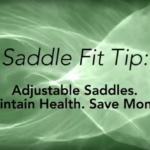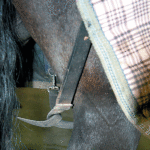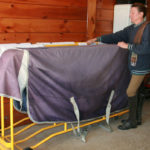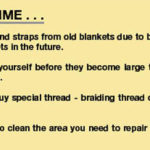As horses emerge in early spring from under their winter blankets, their coats can display a collection of rubbed areas that makes them look a bit moth-eaten. This is mostly a temporary cosmetic matter unless any rubbed spots under the saddle or spur areas persist into the spring or reappear in the summer.
Horses that don’t gather coat rubs in the summer will still often collect balding spots in the winter. Winter coat hairs are simply more fragile. In addition, coat health in general is much harder to maintain in the winter.
Bacteria collect under blankets that aren’t laundered very often, if at all, throughout the winter. Coats are rarely fully exposed to fresh air and the sun’s germ-killing rays. Horses that are working hard in the winter don’t usually get a full body wash with soap and warm water, so dirt, germs and salt collect in the coat. Grooming, which can remove dirt and stimulate blood flow, is often not as thorough when it’s cold in the barn.
When the coat is irritated even just a little bit in these conditions, patches of hair will fall out, sometimes suddenly and in a rather alarming manner. You may deal with the hair loss differently depending on the location.
Any site that has scurf as well as hair loss can benefit from a thorough currying and then a light application of a mild germ-fighting product before putting your horse up after working him. The liniment you probably already have in your tack box should suffice. If the scurf remains for more than a day or two, you’ll need a thorough cleansing with a product designed for that specific purpose.
The most effective hair restoration product we’ve seen over the years is Mega-Tek (EQyss, www.eqyss.com, 800-526-7469). Wash it off five minutes after application. You can leave it on without rinsing if you only use a small amount and rub it well into the skin.
Be careful with any product you apply in the winter since sweat or bathing won’t remove them. Build-up of the product can easily occur and make rubbing worse rather than better.
Under the Saddle: If there are uneven patches of hair loss, be sure to check saddle fit. If the patches are even and not too large, and the skin isn’t sensitive, they’re more likely due to breakage of fragile winter hair.
Curry the back area thoroughly every day. Before riding, apply a small amount of coat polish such as ShowSheen (W.F. Young, www.absorbine.com, 800-628-9653) to the rubbed area so that your pad glides there rather than rubs. Put the polish on your hand to apply, rather than spraying directly on the horse, so that the general saddle area doesn’t become slippery.
Pads with a waffle weave that allow sweaty backs to dry easily in the summer can be rough and irritating in the winter, as can any pads with exposed seams or stitching. The fabric softener or detergent you use for laundering can also cause irritation.
The coat on your horse’s back will stay cleaner if you put on a cotton sheet under his blanket. The sheet can be laundered more easily and more frequently than a heavy blanket.
Spur Area: Rubs in the spur area can be caused, of course, by unsteady and over-busy leg aids. Always consider equitation first for any rub spots in this area.
A common cause of irritation in the spur area, especially in the winter, is a prominent crease in the rider’s boots or chaps, especially suede chaps.
Boots and chaps should be thoroughly cleaned in this area. You may even be able to just throw suede chaps in the washing machine with a product designed to wash leather. Air dry. When they’re nearly dry, rub them thoroughly with a leather softener or even a hand cream so the creases lose their rigidity.
A mildly irritated spur spot in the summer can be cleared up by applying a light coat of petroleum jelly such as Vasoline to the area before riding so that the spur slides over the area. In the winter, however, Vasoline can build up on the coat and also on the chaps. A better ”glide” solution in the winter is to apply ShowSheen before riding.
Spurs that have any type of rowel can catch in long winter coats. The hair then breaks off there or even falls out.
Blanket rubs: The easiest way to prevent blanket rubs is to make sure that the blankets are long-enough. Shoulder rubs are caused by blankets that are caught up on the hip as the horse stretches down to eat. If rubs do appear, blanket liners can help, as can stimulating the coat through currying and application of Mega-Tek.
Strap/Buckle Areas: Winter rubs often appear under bridle buckles, mid-neck where the reins rub, and along the girth. Washing and currying there can help. Watch out for scurf in the girth area. Rub in Mega-Tek after riding to help protect these areas.
Article by Margaret Freeman, Associate Editor.







